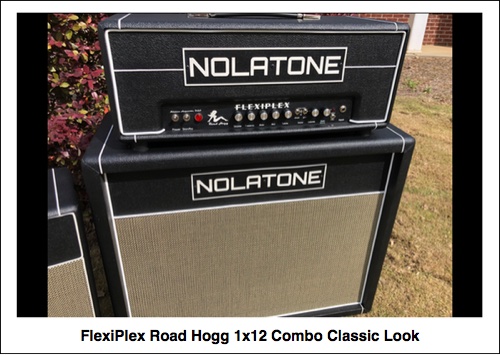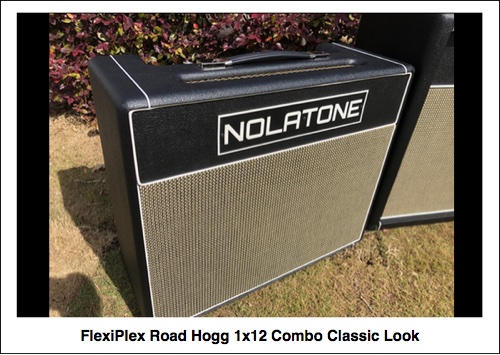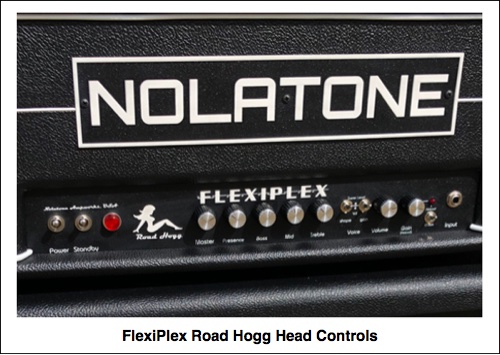

| Power Output | 50 Watts, 37 Watts, or 18 Watts |
| Output Tubes |
|
| Preamp Tubes | 3 - 12AX7 |
| Rectifier |
|
| Controls | Hot Gain, Volume, Treble, Mid, Bass, Presense, Master Volume |
| Panel Switches | Hot Rod Mode, Voice-shape, Voice-gain |
| Options |
|
Click here for Pricing

FlexiPlex Road Hogg
Finally I've found my place in the world of Marshall inspired amps. Ever wonder why so many builders are building clones of the original Marshalls? Because that's what people expect. It took me 8 years to realize that.
It started with the Road Hogg. In traditional Nolatone sprit, I wanted to offer the Marshall experience, only different. So I added features like pentode input, special mid scoop filter, etc. All that changed the formula. People loved it, but I was always perplexed why the die hard Marshall faithful didn't always "get it". Over time I did exhaustive comparisons between the Road Hogg and classic Marshall circuits from early and late '60's. I tweaked the Road Hogg in various ways to bring it closer and closer to the original experience. I finally realized, the Marshall experience is sacred. Marshall faithfuls *expect* it, and those who may be open to more innovation still find that primal connection, so the Road Hogg has evolved into the FlexiPlex Road Hogg.
Nolatone still has to offer something different than a gold panel with 4 holes and 6 knobs, so how did I do that while staying faithful to the sacred Marshall circuit? Here's how...
When Marshall introduced the JTM-45 in 1963, although it's said they copied the tweed Fender Bassman, it changed the world like it's Fender ancestor never could. The classic Marshalls starting with the JTM-45 and the evolution of Marshall amps for the next several years changed the sound of rock and blues music forever.
In the FlexiPlex Road Hogg I've captured what I feel are all the best aspects of the various amps during that era, which is arguably the golden era of amp tone for Marshall.
Being a single channel (with a switchable "Hot Rod" mode), I had a decision to make: The input stage design of the 1963 JTM-45 passes a LOT of bottom end for a more "wooly" sound than the high treble channel of a '69 Super Lead. That sound is special in it's own way, but to me a bit limiting when trying to pull out the classic rock crunch tones.
I designed the input stage more in line with the high treble channel of the Super Lead, though with a bit more meat for a ballsier sound (I've plugged into high treble channels that were a bit crispy and could've used a bit more meat IMO, and the Flexi Plex delivers that). I've found this gives the widest range of absolutely wonderous Marshall tones in the various voicing and gain structure switches available on the FPRH. I believe this is what Jim Marshall would have done had the '69 Super Lead had been a single channel amp.
I find being able to change the voice and gain structure of the SLP high treble channel to that of an early JTM-45 is quite enlightening. If you REALLY want the woolier sound of the JTM-45 I can add a $50 mod (aka the "Wooly Mod") selectable by a panel switch. The result will be fatter, closer to a stock JTM-45 (but of course with the option to set the voice and gain to Super Lead mode!).
The JTM-45, while at a glance, very similar to later Marshall circuits, has a few differences that change the voice and gain structure, and this circuit was tweaked over time serve the needs of musicians. Certainly there are other differences across the first few years, largely the power supply configuration changed as well. The JTM-45 has smaller value filter capacitorss which makes it saggier and bloomier, a different feel. The FPRH can be ordered in a variety of configurations to offer an affinity to your preference.
A 37 watt version uses KT66 output tubes, a transformer set featuring the Mercury Magnetics Radio Spares reproduction output transformer used in the old Blues Breaker amps, with tube rectification and softer filtering to give them that saggier feel. With this configuration you get ultra dynamic tones just oozing with harmonics. In '63 voice, it's a GREAT JTM-45 sound, though (without the "Wooly Mod") not quite as wooly sounding as the earliest JTM-45s due to the tigher voicing of the low end of the FPRH, but you also get the '69 SuperLead voicing options which open up new possibilities you'd never have had in 1963!
A 50 watt version uses the classic Mercury Magnetics Marshall plexi transformer set with EL34s. Its power supply is a bit firmer than the 37 watt version, using diode rectifier just as the originals. It's got the bark and punch of the later 60's rock machines, but still mega dynamic and dripping with harmonics.
If you want even more aggresive, I can beef that filtering on up.
If 18 watt is your thing, the FPRH is offered with a pair of cathode biased EL84s and various tweaks to optimize the circuit to sound best with EL84s. Wooly mod is not available in this configuration. The EL84's just don't sound right with it.
With the FlexiPlex Road Hogg you can take trip through the best years of Marshall amplification all with one amp!!






